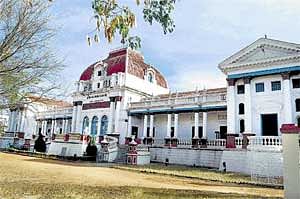
If you happen to walk past the Krishnaraja Boulevard Road, you are bound not to miss the imposing structure on the left side of the road. The majestic building with beautifully carved figurines, a dome and the neatly arranged inscriptions inside generate curiosity. This is the ‘Karma bhumi’ of many stalwarts like Dr R Shamashastri who toiled hard to preserve the priceless manuscripts collected from across the country.
This building was built in 1887 to commemorate the golden jubilee of Queen Victoria’s ascension to the British throne. Subsequently, the Oriental Library was started in 1891 on instructions from Chamaraja Wodeyar, the then Maharaja of the Princely State of Mysore. Initially, it was known as Government Manuscript Library and was re-christened as Oriental Research Institute in 1943. The Institute was dedicated to carry on studies in epigraphy and research in Kannada and Sanskrit. Subsequently, the Kannada research wing was shifted out of here. Till 1916, the Institute was under the Department of Education. It is a research institute that collects, exhibits, edits and publishes rare manuscripts in Sanskrit and Kannada.
Over 200 titles
This Institute has a collection of over 37,000 bundles of palm leaf manuscripts and the exact number may exceed 70,000. From 1893 till date, it has published over 200 titles.
It has a rare collection that comprises works such as ‘Sritattvanidhi’, ‘Manasollasa’, ‘Kautilya’s Arthashastra’ and ‘Amruthakathaka’. Besides, it has the ‘Encyclopaedia of Religion and Ethics’ by James Hastings, a ‘Vedic Concordance’ by Maurice Bloomfield, and critical editions of the Ramayana and Mahabharatha.
Indeed it is the first public library for research and editing of manuscripts. A team of dedicated research scholars are involved in this work. One of the most famous publications of the Institute is Kautilya’s ‘Arthashastra’, written in the fourth century BC, edited by Dr R Shamashastri. This work brought laurels to the Institute when the English translation of the ‘Arthashastra’ was first published in 1909. ‘Sritattvanidhi’ is a compilation of shlokas by Krishnaraja Wodeyar III. The manuscripts are mostly based on works of great scholars, jyotishya (astrology) and Ayurveda.
Smallest and biggest...
Manuscripts are written on two varieties of palm leaves. One is yellow based and another is off-white in colour. In fact, palm trees are found mostly in Asian countries like India, Afghanistan and Srilanka. The size of the manuscript varies.
The ORI has in its possession the smallest and longest manuscripts. The smallest is the size of a matchbox on which the shlokas of ‘Srimad Bhavagad Geeta’ is written. The longest one is ‘Sri Maheshwaracharasanga’ that needs two persons to hold it. This manuscript throws light on traditions of Veerashaivism. It has shlokas in Sanskrit along with translations in Halagannada. It is said to have been written in the 12-13th century.
Longevity is an important feature of these manuscripts as they could be kept intact for 400-500 years with proper and regular maintenance.
Scholars depended on the palm leaves to write as it was the only technology that was available at that time. They used natural ingredients to make palm leaves suitable for writing.
The paste made of ragi was smeared on the surface of pal leaves to soften them before writing. To ensure the paste was black, they would dry banana skin and burn it before powdering it. The leaves of a particular plant were squeezed to get the colour green. Various technologies have been used in preparing natural colours required for writing on the palm leaves.
There is a technique involved even when it comes to tying palm leaves with a thread. The palm leaves are neatly set and covered with two pieces of wood so that pressure falls on those pieces and not on the leaves.
Preserving manuscripts
The ORI has taken all steps to preserve manuscripts. Lemon grass oil is smeared on the manuscript to prevent decay as well as to protect them from termite and ants. This job is assigned to a person who applies lemon grass oil and black powder mixed with a chemical to protect letters written on the manuscripts.
There is a standard procedure even in applying methodology and little negligence breaks the palm leaves. Once-naturally-treated manuscripts are intact for around 10 years.
The Institute is under the control of the University of Mysore which has evinced keen interest in development of ORI as well as restoration of priceless manuscripts. It has a beautiful library which is most useful for researchers interested in studying manuscripts.
Of the collection, around 50 manuscripts are more than 300-400 years ago and 250 of them are 150 years old. The manuscripts became outdated after invention of paper and printing technology.